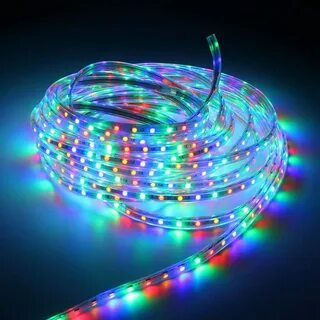
12v led strip lights is low-voltage electricity, and 220V electricity is for civilian use. It can also be sai-d that the input voltage is 220V and the working voltage is 12V.
It is convenient to connect the 220V strip directly to the power source 220V however, it isn't secure.
The low-voltage 12v led strip lights is safer. But when connecting you must connect a transformer before it is connected to the power source.
The 220V connector for light strips is equipped with an internal converter with a rectifier with constant current output. The voltage at which the plug is output from the rectified and the filtered plug is 300V DC.
It controls the output current via constant current conversion tens milliamperes DC for driving the LED light strips. The 12V light strip isn't equipped with the converter, but 12V DC is used to power the LED strip.
LED Selection Parameters and 12v Direct Drive Led Strip Lights
Let's start by letting me ask a question, is it possible to directly drive a light-emitting transistor in series with an resistor?
The maximum operating current of low-power LED lamp beads that come in various colors is generally 20mA, but the actual amount is 5 to 15mA.
The forward voltage drop for red LEDs is usually 1.62V. Green ones generally 1.82.4V and white or blue are 33.3V.
Consider that a blue light beads is powered with a 12V power source and the operating voltage is 9mA. Then, the current-limiting resistor R equals (12V-3V/9mA) = 1KO. 3V in this formula is the voltage drop that is forward of the blue lamp bead.
Despite the fact that I selected the LED option, it still created problems for me. The brightness isn't quite comparable to the three-color light. However, I only see red.
The 3535MWAP of Nationstar Optoelectronics has been chosen.
IF: refers to the forward current, which refers to the current when the LED strip light is in operation. The working current for ordinary dimmers emitting light is typically very low, between 10mA and 45mA.
Light-emitting Diodes (LEDs) are connected in series and protected by resistors. them from voltage spikes.
LD: wavelength.
Different materials used in the die are able to produce different colors.
Even for the same material the luminescent color can be obtained by altering the kind or concentration of impurities or changing the composition of the substance.
The table below lists the different luminescent materials which are utilized in LEDs.
The material used for the Luminous color is Wavelength
Ordinary red GaP 700
Red GaAsP with high brilliance.
GaAlAs 660 Super bright red
AlGaInP Super bright red 625-640
Green normal GaP 565-572
High Brilliance Green AlGaInP
Super bright green InGaNg 505-540
GaAsP in normal yellow 590-610
Super bright yellow AlGaInP 590-610
Light intensity IV
The intensity of light I represents the light flux that is released from the lightsource in an angle unit.
Millicandela is a unit for luminous intensities, which is also known as candela.
Candela is the luminous intensity of an object of light in a specific direction. Candela is the luminous intensity of any light source that is located in the given direction.
VF: forward voltage
Forward voltage is the difference in voltage between the positive electrode and the negative when the current flowing forward through the LED reaches the level of a certain. The voltage drop is symbolized in the form of a symbol "VF".
Our company uses SMD LEDs that have the forward voltage of 2.0V to 3.5V.
The diode could be damaged If the voltage is higher than the operating limit. Furthermore, if the voltage in front is lower than a specific amount (called the threshold) The current is extremely low and the light source is not released.
When the voltage is above an arbitrary level, the forward current rapidly increases along with the voltage.
The light isn't correct because the measured voltage drop forward is only few Volts.
View angle: perspective
In the luminous intensity distribution graph the angle formed by light intensity equal to the half of the maximum intensity is referred to as the half value angle.
As shown in Figure <5>.
In the figure the normal direction of the LED is that of the mechanical axis, the direction of maximum light intensity is the direction of the optical axis and the angle that lies between the mechanical axis and optical axis changes to the angle of deviation.
The chip's thickness, the dimensions overall of the packaging mold strip, how deep the bracket reflector cup and the insertion depth of the bracket in the mold cavity all have a direct impact on half value angles.
Half-value angles of various sizes can be manufactured by choosing various materials and sizes of packages based on customer requirements.
There are three types in relation to the luminous intensity angular distribution diagram:
High directivity can be achieved using metal cavity packaging made of reflective metal or epoxy pointed packaging. This is possible without the addition of scattering agents.
The half-value angle is 5 deg to 20 deg or less. The high-directivity light can be used as a local source of light or with a light sensor to make an automated detection system.
b Standard type, typically used as an indicator light,with a half-value angle from 20deg to 45deg.
c scattering type. It is an indicator light with an extended viewing angle with half-value angles of 45deg-90deg or more.